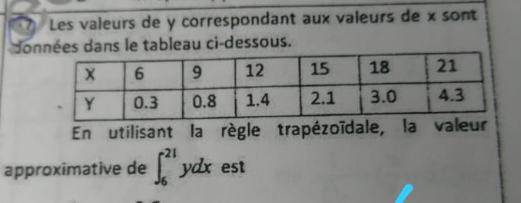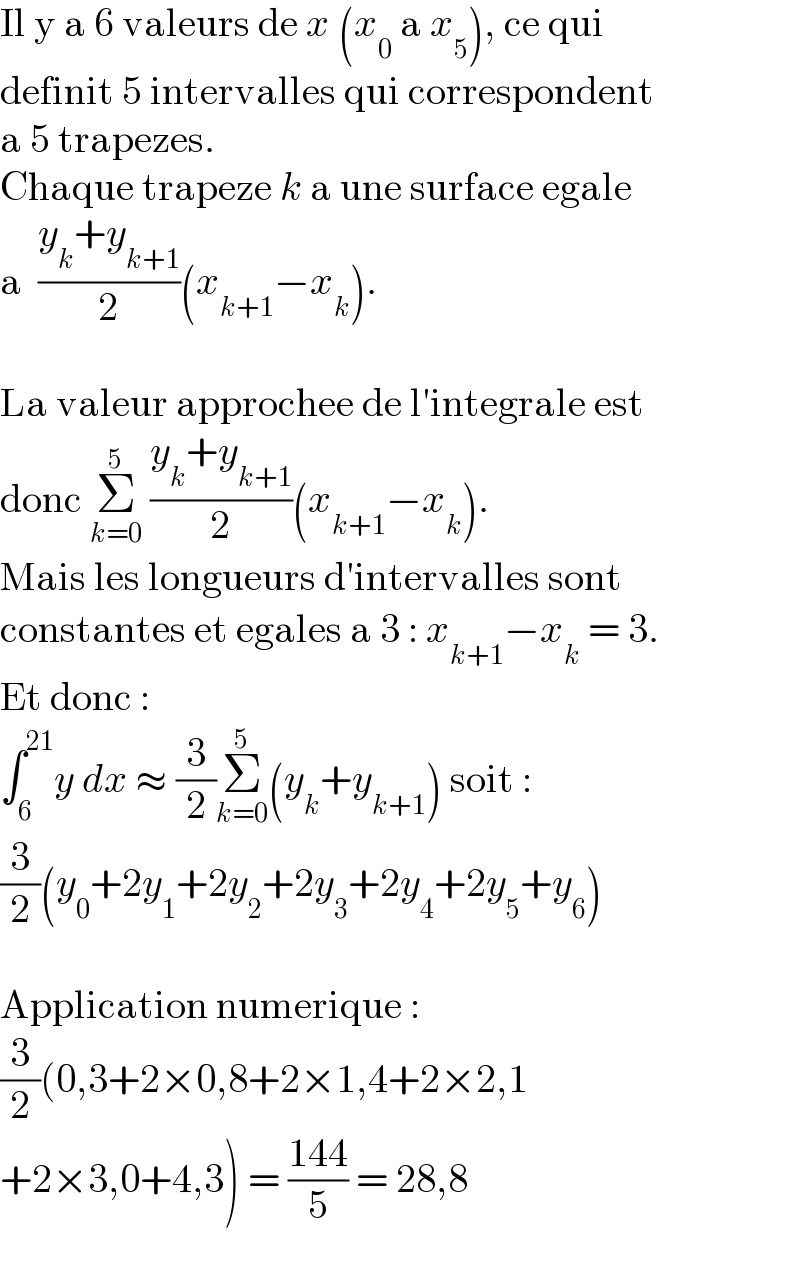Question Number 147904 by puissant last updated on 24/Jul/21

Answered by Olaf_Thorendsen last updated on 24/Jul/21

$$\mathrm{Il}\:\mathrm{y}\:\mathrm{a}\:\mathrm{6}\:\mathrm{valeurs}\:\mathrm{de}\:{x}\:\left({x}_{\mathrm{0}} \:\mathrm{a}\:{x}_{\mathrm{5}} \right),\:\mathrm{ce}\:\mathrm{qui} \\ $$$$\mathrm{definit}\:\mathrm{5}\:\mathrm{intervalles}\:\mathrm{qui}\:\mathrm{correspondent} \\ $$$$\mathrm{a}\:\mathrm{5}\:\mathrm{trapezes}. \\ $$$$\mathrm{Chaque}\:\mathrm{trapeze}\:{k}\:\mathrm{a}\:\mathrm{une}\:\mathrm{surface}\:\mathrm{egale} \\ $$$$\mathrm{a}\:\:\frac{{y}_{{k}} +{y}_{{k}+\mathrm{1}} }{\mathrm{2}}\left({x}_{{k}+\mathrm{1}} −{x}_{{k}} \right). \\ $$$$ \\ $$$$\mathrm{La}\:\mathrm{valeur}\:\mathrm{approchee}\:\mathrm{de}\:\mathrm{l}'\mathrm{integrale}\:\mathrm{est} \\ $$$$\mathrm{donc}\:\underset{{k}=\mathrm{0}} {\overset{\mathrm{5}} {\sum}}\:\frac{{y}_{{k}} +{y}_{{k}+\mathrm{1}} }{\mathrm{2}}\left({x}_{{k}+\mathrm{1}} −{x}_{{k}} \right). \\ $$$$\mathrm{Mais}\:\mathrm{les}\:\mathrm{longueurs}\:\mathrm{d}'\mathrm{intervalles}\:\mathrm{sont} \\ $$$$\mathrm{constantes}\:\mathrm{et}\:\mathrm{egales}\:\mathrm{a}\:\mathrm{3}\::\:{x}_{{k}+\mathrm{1}} −{x}_{{k}} \:=\:\mathrm{3}. \\ $$$$\mathrm{Et}\:\mathrm{donc}\:: \\ $$$$\int_{\mathrm{6}} ^{\mathrm{21}} {y}\:{dx}\:\approx\:\frac{\mathrm{3}}{\mathrm{2}}\underset{{k}=\mathrm{0}} {\overset{\mathrm{5}} {\sum}}\left({y}_{{k}} +{y}_{{k}+\mathrm{1}} \right)\:\mathrm{soit}\:: \\ $$$$\frac{\mathrm{3}}{\mathrm{2}}\left({y}_{\mathrm{0}} +\mathrm{2}{y}_{\mathrm{1}} +\mathrm{2}{y}_{\mathrm{2}} +\mathrm{2}{y}_{\mathrm{3}} +\mathrm{2}{y}_{\mathrm{4}} +\mathrm{2}{y}_{\mathrm{5}} +{y}_{\mathrm{6}} \right) \\ $$$$ \\ $$$$\mathrm{Application}\:\mathrm{numerique}\:: \\ $$$$\frac{\mathrm{3}}{\mathrm{2}}\left(\mathrm{0},\mathrm{3}+\mathrm{2}×\mathrm{0},\mathrm{8}+\mathrm{2}×\mathrm{1},\mathrm{4}+\mathrm{2}×\mathrm{2},\mathrm{1}\right. \\ $$$$\left.+\mathrm{2}×\mathrm{3},\mathrm{0}+\mathrm{4},\mathrm{3}\right)\:=\:\frac{\mathrm{144}}{\mathrm{5}}\:=\:\mathrm{28},\mathrm{8} \\ $$
